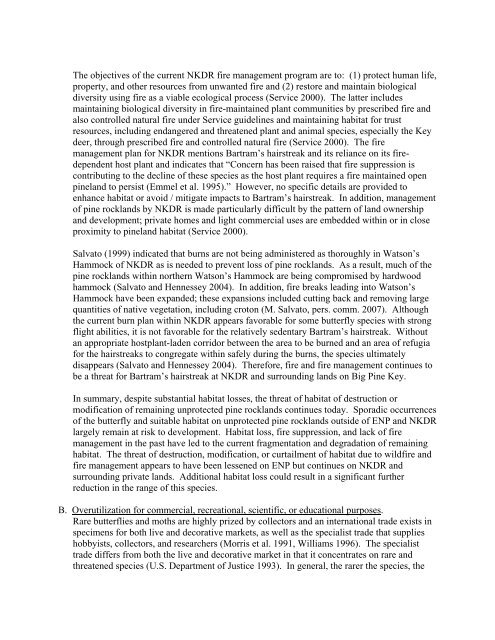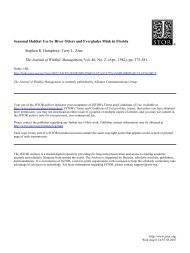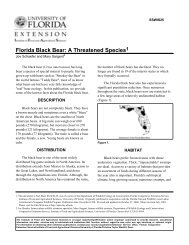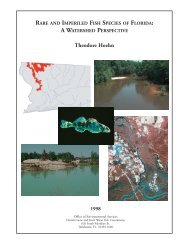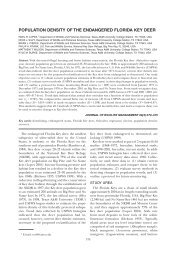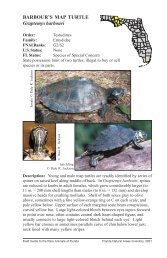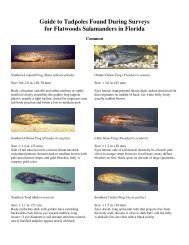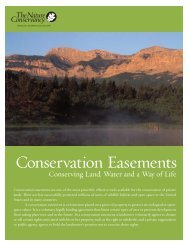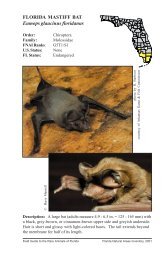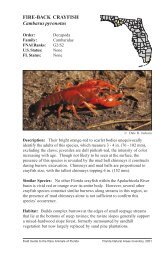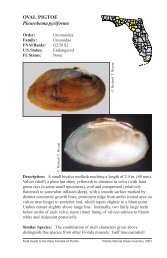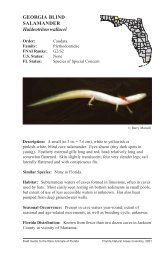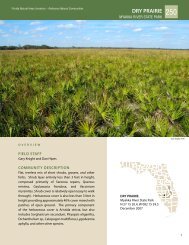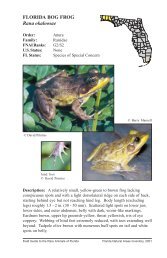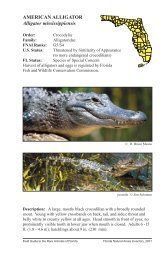Bartram's hairstreak butterfly - Florida Wildlife Conservation Guide
Bartram's hairstreak butterfly - Florida Wildlife Conservation Guide
Bartram's hairstreak butterfly - Florida Wildlife Conservation Guide
Create successful ePaper yourself
Turn your PDF publications into a flip-book with our unique Google optimized e-Paper software.
The objectives of the current NKDR fire management program are to: (1) protect human life,<br />
property, and other resources from unwanted fire and (2) restore and maintain biological<br />
diversity using fire as a viable ecological process (Service 2000). The latter includes<br />
maintaining biological diversity in fire-maintained plant communities by prescribed fire and<br />
also controlled natural fire under Service guidelines and maintaining habitat for trust<br />
resources, including endangered and threatened plant and animal species, especially the Key<br />
deer, through prescribed fire and controlled natural fire (Service 2000). The fire<br />
management plan for NKDR mentions Bartram’s <strong>hairstreak</strong> and its reliance on its firedependent<br />
host plant and indicates that “Concern has been raised that fire suppression is<br />
contributing to the decline of these species as the host plant requires a fire maintained open<br />
pineland to persist (Emmel et al. 1995).” However, no specific details are provided to<br />
enhance habitat or avoid / mitigate impacts to Bartram’s <strong>hairstreak</strong>. In addition, management<br />
of pine rocklands by NKDR is made particularly difficult by the pattern of land ownership<br />
and development; private homes and light commercial uses are embedded within or in close<br />
proximity to pineland habitat (Service 2000).<br />
Salvato (1999) indicated that burns are not being administered as thoroughly in Watson’s<br />
Hammock of NKDR as is needed to prevent loss of pine rocklands. As a result, much of the<br />
pine rocklands within northern Watson’s Hammock are being compromised by hardwood<br />
hammock (Salvato and Hennessey 2004). In addition, fire breaks leading into Watson’s<br />
Hammock have been expanded; these expansions included cutting back and removing large<br />
quantities of native vegetation, including croton (M. Salvato, pers. comm. 2007). Although<br />
the current burn plan within NKDR appears favorable for some <strong>butterfly</strong> species with strong<br />
flight abilities, it is not favorable for the relatively sedentary Bartram’s <strong>hairstreak</strong>. Without<br />
an appropriate hostplant-laden corridor between the area to be burned and an area of refugia<br />
for the <strong>hairstreak</strong>s to congregate within safely during the burns, the species ultimately<br />
disappears (Salvato and Hennessey 2004). Therefore, fire and fire management continues to<br />
be a threat for Bartram’s <strong>hairstreak</strong> at NKDR and surrounding lands on Big Pine Key.<br />
In summary, despite substantial habitat losses, the threat of habitat of destruction or<br />
modification of remaining unprotected pine rocklands continues today. Sporadic occurrences<br />
of the <strong>butterfly</strong> and suitable habitat on unprotected pine rocklands outside of ENP and NKDR<br />
largely remain at risk to development. Habitat loss, fire suppression, and lack of fire<br />
management in the past have led to the current fragmentation and degradation of remaining<br />
habitat. The threat of destruction, modification, or curtailment of habitat due to wildfire and<br />
fire management appears to have been lessened on ENP but continues on NKDR and<br />
surrounding private lands. Additional habitat loss could result in a significant further<br />
reduction in the range of this species.<br />
B. Overutilization for commercial, recreational, scientific, or educational purposes.<br />
Rare butterflies and moths are highly prized by collectors and an international trade exists in<br />
specimens for both live and decorative markets, as well as the specialist trade that supplies<br />
hobbyists, collectors, and researchers (Morris et al. 1991, Williams 1996). The specialist<br />
trade differs from both the live and decorative market in that it concentrates on rare and<br />
threatened species (U.S. Department of Justice 1993). In general, the rarer the species, the


